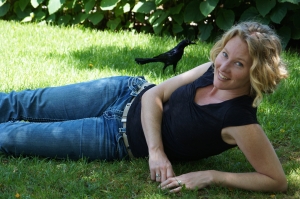It’s so early it’s still dark and I’m driving to a cold, windy beach in Santa Barbara, California to catch grackles next to a roosting site I found the week before. Great-tailed grackles (Quiscalus mexicanus) are one of the most invasive native species in North America and they are presumed to be so successful because of their flexible behavior that allows them to adapt to new situations. However, their intelligence has not yet been tested so we don’t know for sure. Until now. Armed with a grant from the National Geographic Society / Waitt Grants Program and a fellowship from the SAGE Center for the Study of the Mind at the University of California Santa Barbara, I set out to determine how these grackles compare to New Caledonian crows when tested on the same experiments. I caught four grackles at a time and brought them into aviaries to give them choice tests, and I found that on some of the tests, they are as good as the crows. As well, both species show flexible behaviors (Logan et al. 2014, Logan 2015). According to common assumptions, this is surprising because crows have much bigger brains than grackles. However, new research is showing that a larger brain doesn’t necessarily mean there are more neurons, and since neurons are the substrate on which cognition occurs, neuron number is more likely to be the crucial measure for predicting which species should possess complex cognition (Herculano-Houzel et al. 2009, Kazu et al. 2014). The grackles are amazing to work with: they habituate to the aviary almost instantly and readily choose to participate in the choice tests.
Each one seems to have their own personality: Michelada appeared curious about human behavior because she would sit as close as she could to us and watch whatever we were doing. I wonder what she was thinking.
I put unique combinations of colored rings on their legs so I can identify individuals and study their behavior in the wild to answer questions about whether individual differences in cognitive abilities provide fitness benefits (e.g., increased numbers of offspring). One of my favorite parts of this research is when I get to take the aviary grackles back to the beach where I caught them, open the door to their transport cages, and watch them fly free in the wild again.
Corina Logan
Alumna and Leverhulme Early Career Research Fellow, Department of Zoology, University of Cambridge
Do you want to see what life in the field is like in New Caledonia? Check out my National Geographic Explorers Journal video blog http://newswatch.nationalgeographic.com/author/corinalogan/
See the latest grackle news on twitter https://twitter.com/LoganCorina
References
Herculano-Houzel, S. (2009). The human brain in numbers: a linearly scaled-up primate brain. Frontiers in human neuroscience, 3.
Kazu, R. S., Maldonado, J., Mota, B., Manger, P. R., & Herculano-Houzel, S. (2014). Cellular scaling rules for the brain of Artiodactyla include a highly folded cortex with few neurons. Frontiers in neuroanatomy, 8.
Logan CJ, Jelbert SA, Breen AJ, Gray RD, Taylor AH (2014) Modifications to the Aesop’s Fable paradigm change performances in New Caledonian crows. PLOS ONE 9:e103049. doi:10.1371/journal.pone.0103049
Logan CJ. 2015. Innovation does not indicate behavioral flexibility in great-tailed grackles. bioRxiv. doi: http://dx.doi.org/10.1101/027706.
